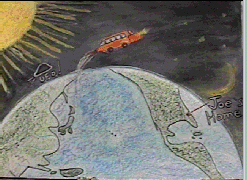 First Lesson (pictures 1 through 5 of the
storyboard) Learn where the visiting foreigner is from and see earth get smaller and
smaller.
First Lesson (pictures 1 through 5 of the
storyboard) Learn where the visiting foreigner is from and see earth get smaller and
smaller.
Fall 1998
http://www.worldclass.net/index.html
Primary and secondary school curriculum and projects for
team-teaching with an AET:
connecting international understanding, multi-media, environmental studies and English
as-a-second-language
Introduction
The largest program for international education in the world, the
Japan Exchange and Teaching (JET) program, sponsored by Japan's Ministry of Education
(Monbushou), now includes more than 5000 participants from more than 26 countries.
Over half of this total visits junior high school and primary schools to cultivate
international understanding and introduce basic English-as-a-second language conversation
skills. It sounds great, but according to a 1998 survey sent to all JET
participants, over half of the teachers feel that they do not have enough work; and, when
they do have it, the work lacks purpose and is not challenging. There are at least
two factors that help account for these problems: 1) The current curriculum in the
schools does not designate specific class time or guidance for the subject of
international understanding. 2) The AET does not usually have enough ability in
Japanese to communicate with the students or teachers effectively.
These two factors combined can often leave the students feeling the same way as the
AET, a sense of a lack of purpose and challenge in the class. Consequently,
time is often wasted and international misunderstanding becomes predominant. Even in
the junior high school, there are similar problems. Outside of English class, there
are few chances for the AET to participate in relevant classes like world history or
social studies.
In attempt to solve these problems, I began to develop some curriculum for the
primary schools to build a foundation for international understanding. In the upper
primary school grades and junior high school level as well, I started some
cross-curricular projects for AET participation. This work is based on my three
years teaching in three primary schools and one junior high school in two towns,
Nakamichi-cho and Toyotomi-mura, in Yamanashi-ken, Japan. I would like to thank
Aoyagi Sayuri, a master teacher at Nakamichi-Minami primary school, for helping me write
the Japanese version of this report. I would also like to express thanks to
Professor Sawamoto (Yamanashi University) and Professor Arita (Aiichi University), whose
workshop in the summer of 1997 helped me establish an effective process of class
reflection and improvement of my classes--in particular, Everyone's Birthday Party.
Building impressions of the world:
from the "Big Pictures" to exchange projects
To better utilize the skills and experiences of the AET and improve the classes--ideally, a well developed cross-curriculum for AET participation in various subjects is necessary. There has not yet been such curriculum support, however; and consequently, the AET usually has to develop curriculum and class plans on his or her own. Almost all of the visiting AETs first use a world map to introduce their home country and then continue with English songs and games. This method of teaching is not at all bad, but after ten or twelve times, the novelty of having a foreigner in class has worn off, and the students begin to require more class content. For example, here are a few questions that came up during free discussion time in my classes.
These questions may appear cute, but upon deeper consideration, it becomes clear
that the students are not being given much of formal introduction to the world during
their most impressionable years. Thoughtful lessons designed to answer to such
questions, I thought, would give students more of a reason to communicate and participate
in a global society. Because I had just finished graduate school in world history
at the University of Hawaii and I had basic Japanese speaking ability, I decided to try to
develop some curriculum for primary grades to introduce basic world geography and world
history. If possible, I wanted to cultivate students' affinity with all of life on
earth and its peoples; and finally, make them realize that English-as-a-foreign language
is a useful communication tool, not a subject forced upon them by the Ministry of
Education.
Parts 1 through 4 in the Curriculum Contents cover the first twelve teaching units
in primary classes, team-taught in a variety of subjects. 1) the picture board, School
Bus Rocket, introduces a simple geography of the earth in space; 2) the
picture board, Everyone's Birthday Party, shows how everyone's birthday
is connected--from a star's birthday to all life and people on earth; 3) the
"draw-and-tell" story, Turtle Island, introduces a famous North
American folk story showing how people have made-up stories to describe their relationship
with the local environment; 4) finally, in the "draw-and-tell" story, English
Explorers, students draw their own steam-boats and learn how English came to be
used in different parts of the world. Each lesson includes simple English words and
phrases and follow-up games and songs to review the work. This report includes a
detailed description of each lesson, the story itself, and the results of student
questionnaires divided between lower and upper primary school grades.
Part 5 in the Table of Contents builds on the first four themes and applies
English as tool for international exchange activities from the first grade in primary
school through the third grade in junior high school (grade 9). By combining
multi-media with various subjects, students' reasons to use English expands beyond
conversation with the AET.
At the lower primary school level, a first grade primary school teacher in Japan
used a teachers' mailing list to conduct a very interesting exchange with a first grade
class in Boston, U.S.A.
At the upper primary school level, students conducted an exchange with a school in
France and we used the materials we received to create a France impressions web-page.
At the junior high school level, classes conducted exchanges with a variety
of countries including the U.S.A. and Korea. We learned a lot about the cultural
variety in the U.S.A. and the views Korean students have of Japan. We used our
exchange materials to create various web-pages, including one impressions web page of our
local region.
Finally, we combined international understanding, English-as-a-foreign language,
and environmental education in various clubs in upper primary school grades and junior
high school grades to begin a data base web-pages shared between three primary schools and
a junior high school. Volunteer activities in the junior high school Chemistry Club;
the primary school English and personal computer clubs make up the initial data.
Student surveys administered to second through fifth graders up to a year-and-a-half after their classes show that the classes left a lasting impression. Simple stories describing the earth in space, the relationship between all of life and peoples on earth in world history, folk stories, and fun stories describing the modern world helped begin to establish a foundation for international understanding. Best of all, the classes become more challenging and rewarding for the students and the AET. I hope that the curriculum will continue to be developed by colleges of education and attached primary and secondary schools.
Table of Contents
School Bus Rocket
(an introduction to the geography
of the earth in space)
The first story, School
Bus Rocket, teaches a simple geography of space. The story draws some inspiration
from Joanne Cole's Magic
School Bus (scholastic.com/magicschoolbus/index.htm) series as well as the United Nations' Cyber School Bus (un.org/Pubs/CyberSchoolBus/) web pages, but the content
and context of this story is quite different and designed for learners of
English-as-a-second language in Japan. The story-line is simple and progresses
through each level of our known universe: the earth, the solar system, our galaxy, the
Milky Way, and other galaxies, black holes, the birth of a star; and back to earth again. The
story is divided into two parts and can be taught over two to three hours including word
recognition games. Even first graders enjoy it!
Purpose and class outline for three hours in the first semester
 First Lesson (pictures 1 through 5 of the
storyboard) Learn where the visiting foreigner is from and see earth get smaller and
smaller.
First Lesson (pictures 1 through 5 of the
storyboard) Learn where the visiting foreigner is from and see earth get smaller and
smaller.
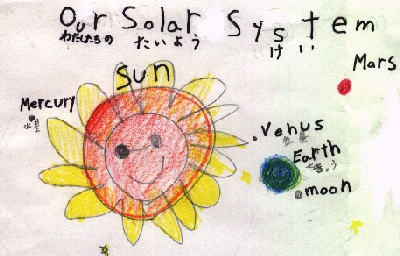 Second Lesson
(pictures 6 through 10)story continued from the previous lesson. Return to Earth and
draw a picture.
Second Lesson
(pictures 6 through 10)story continued from the previous lesson. Return to Earth and
draw a picture.
Third Lesson (review and games) Explain our drawings and practice English.
Student Survey
(one year after the class)
Lower primary grades
Nakamichi-Kita primary school, third grade (actual class second grade), 29 students
1) What did you think of the lesson?
2) What was the best part?
Going into the black hole (9 students). Drawing our own picture (4). The School Bus Rocket was the best (3). Drawing our own bus was the best (2). Seeing the Milky Way was the best (2). I could understand space well (2). The black hole looked like it was going to collapse (1). The picture of the earth was interesting (1). The big earth was the best (1). I could learn a little English (1). When we took-off into space (1).
Nakamichi-Minami Primary school, fourth grade (actual class third grade), 29 students
1) What did you think of the lesson?
Learning about space was easy to understand (4 students). It was interesting (4). I could learn how to read English using the story board (3). I want to go to space (2). It was fun to see lots of stars (2). This kind of studying was good (2). It was fun to draw pictures (2). The school bus rocket made me feel like I really went into space (1). I want to hear the story again (1). It was fun to see all the pictures of other galaxies (1). When I saw the picture of the Milky Way, I wanted to see the real thing too (1). I thought that the Milky Way is beautiful (1). I thought that it would be great if we could really go to space and see a black hole (1).
2) What was the best part?
The black hole (6 students). Drawing pictures of galaxies (2). Everyone got to go up on the school bus rocket on an adventure together (1). I could understand a lot about space (1). The Solar System (1). The Milky Way (1). We could go into space and see a lot of things (1). We could see Joe's hometown on the earth (1). The story-board was good. I learned some English (1). The English KARUTA game was good (1).
Nakamichi-Kita primary school, fourth grade (actual class third grade) 27 students
1) What did you think of the lesson?
The School Bus Rocket was fun and interesting (11 students). It was easy to understand the English words, "Milky Way," "Moon," "Star," etc. (5). I realized that there are a lot of stars in space (4). I wanted to go into the Black Hole (2). It was fun to draw different pictures of space (2). It was fun to hear such a story (1). I did not want to come back to earth (1). I thought it was mysterious (1). It was fun to learn about space and learn some English (1).
2) What was the best part?
The school bus rocket (8 students). The Black Hole (7). Learning English words (4). The earth got smaller and smaller (2). Drawing pictures (2). Playing English KARUTA (2). The Milky Way (1). When the kids went into space (1).
Toyotomi primary school, fourth grade (actual class third grade), 35 students
1) What did you think of the lesson?
I could understand a lot about space (15 students). It was fun (7). The lesson was easy to understand (3). The English was difficult, but interesting (2). Using the storyboard, I could understand a lot of English about space (3). I could understand a lot about the different names of planets (2). I didn't know there were black holes in space (2). Riding the school bus rocket made me feel good (1). I was amazed that I could learn things that I didn't know already (1).
2) What was the best part?
The English KARUTA game (15 students). Seeing the black hole (7). The pictures and the story (3). The storyboard (2). Seeing the earth from space (1). Drawing our picture (2). Learning about space (1). I began to want to travel to space (1). Learning the English words for different things in space. The English song (1).
Upper Primary Grades
Toyotomi primary school, fifth grade, homeroom #2 (actual class was fourth grade), 18 students
1) What did you think of the lesson?
2) What was the best part?
Going into space on the school bus rocket (2 students). Understanding more about space (2). Learning the English words for things in space (2). Remembering the planets' names (1). The school bus rocket take off (1). Drawing pictures (1). I thought the Milky Way was beautiful (1). Black Hole (1). The pictures (1). The Solar System picture (1). Learning the English words for the Solar System (1).
Nakamichi-Kita Primary School, sixth grade (actual class fifth grade), 20 students.
1) What did you think of the lesson?
I could begin to learn how to pronounce some English words and understand how to read the words (6 students). I could understand the location of stars, the Solar System, the Milky Way, and other things in space. The study was interesting and fun (2). Learning English while we learned about space was good (2). It was easy to understand the pictures because you made a story for them (2). Seeing where Joe is from was good (1). I realized that space is really big (1). I wished there really was a school bus rocket (1).
2)What was the best part?
The Black Hole (5 students). The story board (4). Seeing the Milky Way and other galaxies (2). Learning the English names for stars and planets (3). The game, English KARUTA (2). The adventure in space on the school bus rocket (2).Understanding space (1). Learning the colors of the stars (1). Drawing [our own] pictures (1). Its good to have a story with a dream (1).
School Bus Rocket
worldclass.net/storybox/rocket/sbr.html
Everyone's Birthday Party
(an fun introduction to the history of space and life on earth)
The second story, Everyone's Birthday
Party, gives a simple, adventurous view of the history of space and life on earth
as a series of inter-connected birthdays. The story is told through the imaginary diary
of a six year old boy who just had a birthday party. The boy notices that there are the
same number of people at his party as his age, he gives a year to each person to divide
his age. This method of dividing time into the number of people in the room is used
again when the brightest star takes the kids on a birthday adventure to the "Big
Birthdays Room." The star divides his age between thirty people -- the six kids and
twenty-four space spirits in the room -- to show how everyone's birthday is connected.
The star then zooms-in on the last person representing the last 500 million years.
Students learn to divide this time-span on our upper body and review the story of
land-life on earth. Humans come into the birthday story in the last centimeter on
the students wrists. We zoom-in even further on this story to see the story of human
migrations to all parts of world during the last five hundred thousand years. The story
pays special attention to changes in skin color and eye shape depending on the new
environments people encountered. The story is divided into three parts and can be
taught in three or four hours including word recognition games.
Purpose and class outline for four hours in the second semester
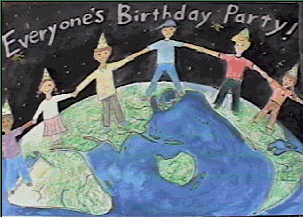 Lesson One (pictures 1 through 3 of the
storyboard) A Birthday Party: know that everyone has a birthday, even a star.
Lesson One (pictures 1 through 3 of the
storyboard) A Birthday Party: know that everyone has a birthday, even a star.
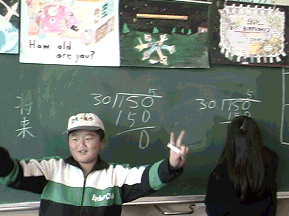
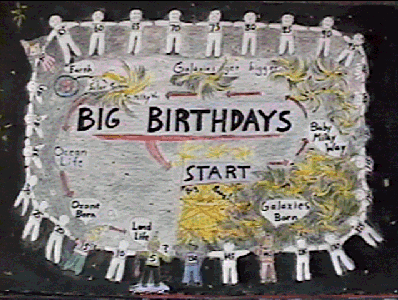 Lesson Two
(Pictures 4 and 5) Big Birthday Room: we take a "birthday adventure" to see the
connections between birthdays in space and life on earth.
Lesson Two
(Pictures 4 and 5) Big Birthday Room: we take a "birthday adventure" to see the
connections between birthdays in space and life on earth.
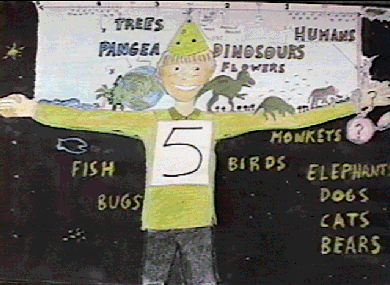 By the 28th person, we see the birth of the Ozone shield around the earth
which allows life to be born on land. To get to the 28th person, we practice the
English words: Twenty-second, Twenty-third, . . . Twenty-eighth, Ozone, Land Life)
By the 28th person, we see the birth of the Ozone shield around the earth
which allows life to be born on land. To get to the 28th person, we practice the
English words: Twenty-second, Twenty-third, . . . Twenty-eighth, Ozone, Land Life)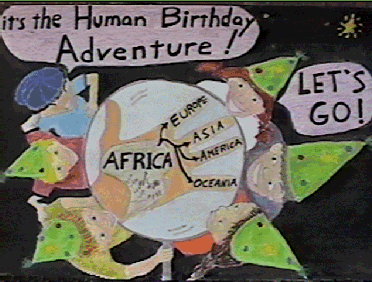 Lesson 3 (pictures 6 through 11)
"Human Birthday Adventure" (The adventure of human birthdays: he story of how
the family of humans were born and came to migrate around the world.
Lesson 3 (pictures 6 through 11)
"Human Birthday Adventure" (The adventure of human birthdays: he story of how
the family of humans were born and came to migrate around the world.
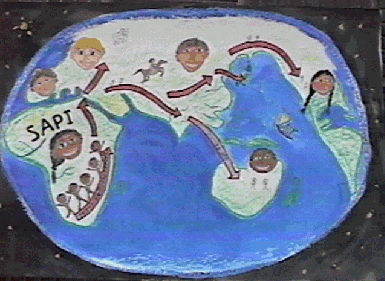 At the end of the last ice-age, big brothers Peking and Java, and little
brother Neanda leave home for Asia and Europe and never come back (picture #9).
At the end of the last ice-age, big brothers Peking and Java, and little
brother Neanda leave home for Asia and Europe and never come back (picture #9).Lesson 4 (Review of the story) Students give their opinions about the story, and we play KARUTA and/or Bingo to review the English words and phrases.
Student Survey Results
(9 months after the lesson)
Lower Primary Grades
Nakamichi-Kita Primary School, third grade (actual class second grade)
1) What did you think of the lesson?
I couldn't believe that the star is 150 billion years old (7 students). I realized that everyone's birthday is connected (2). I could understood birthdays (2). I was amazed (2). I could understand many things (2). It was fun (1). I didn't' understand, but it was interesting (1). I could understand the star's age (1). It was fun asking the star how old he is (1). The "Big Birthdays Room" filled aliens was fun (1). I could understand how long there has been life on earth (1). I enjoyed the birthday song (1). I learned how to ask someone how old he is, and ask a star how old he is (1). It was fun studying about birthdays (1).
2) What was the best part?
The birthday party (7 students). Understanding the star's age (2). The pictures were good and it was fun (2). I liked the picture of the body with animals on it (2). I could understand more about stars (2). The English KARUTA game (2). I could understand the interesting birthday parts (1). It was good that you could make it all interesting (1). It was a fun story and I want to hear it again (1). The star's birthday party was fun (1). When the star told everyone his age (1).
Nakamichi-Minami Primary School, fourth grade (actual class third grade), 29 students
1) What did you think of the lesson?
I couldn't believe the star was 15 billion years old. I was surprised and though it was great! (11 students). It was fun and interesting (4). I thought it was a very good party (1). I thought that my age (10 years) was very different from the star's age (15 billion years) (1). The birthday adventure was interesting (1). This was the first time I understood the history of human birthdays (1). I could understand how our birthdays are connected (1). I realized that all living things have birthdays (1). I thought to myself many times, "that's how it is!" (1). I'd like to go one time on a birthday adventure too (1). I'd like to live 15 billion years like a star (1).
2) What was the best part?
The star is 15 billion years old (4 students). The birthday party (3). It was interesting to see so many things on the birthday adventure (3). I could hear English (3). [The "Big Birthdays Room"] where everyone's hands were joined (2). The whole storyboard (2). Hearing the story (1). When the star joined the birthday party (1).
Nakamichi-Kita Primary School, fourth grade (actual class third grade), 27 students
1) What did you think of the lesson?
It was good, fun, and interesting (10 students). I was amazed that the star was 15 billion years old (5). The party and all the different stories in the party were fun (2). The dinosaurs' birthday was especially interesting (1). I thought that it was an interesting party (1). I enjoyed asking the star how old he is (1). I thought that the star is REALLY an old man if he is 15 billion years old. It was good to know how long the dinosaurs were alive (1). I got real excited by the story (1).
2) What was the best part?
Joe's story (8). The [Big Birthdays Room] where [its] everyone's birthday party (5). The star is 15 billion years old (8). The pictures of the earth (3). I thought that birthdays are fun, so this story was fun (1). Drawing pictures (1). When we asked the star how old he is (1). It was interesting that the star gets older (1). When everyone was playing [outside] (1).
Toyotomi Primary School, fourth grade (actual class third grade), 35 students
1) What did you think of the lesson?
I was amazed that a star is 15 billion years old (18). It was fun and interesting (7). I could understand the star's age (3). It was fun to sing a song (2). It was interesting to hear an English story (1). I could understand how to ask the age of someone (1). I realized that the stars were here long before I was born (1). I could really understand about space (1). I thought that the story was very mysterious (1).
2) What was the best part?
Understanding the star's age (7). It was interesting to do the class in the style of a birthday party (6). The Big Birthday Room in space where it was everyone's birthday party (4). The song was fun (3). The story (3). The KARUTA English game (2). The pictures (2). The Birthday Adventure(1). Understanding more about space (1). Remembering English (1).
Upper Primary Grades
Toyotomi Primary School, fifth grade--homeroom #2, (actual class fourth grade), 18 students
1)What did you think of the lesson?
I was amazed that the star was 15 billion years old (6). I wondered if stars can get old (2). It was fun (3). I thought that having a birthday was fun (1). I wondered if stars are alive (1). I'd like to live 15 billion years (1). Stars live a lot longer than people (1). That was the first time I'd heard the story (1). It was good to sing a fun song (1). The Birthday Party was fun because it was Everyone's party (1). I could understand about birthdays more (1). It was great study (1). I could understand English (1). The story board was good (1).
2) What was the best part?
The birthday (1). It happened to be my birthday too, so it was really fun to celebrate together (1). I'd like to talk to a star too (1). It was good to hear the story (1). We don't hear stories like this often, so it was good (8). The star's birthday adventure stories (1). The Big Birthdays Room (1). The pictures (1). The story-board (1).
Nakamichi-Kita primary school sixth grade--homeroom #1, sixth grade (actual class fifth grade), 20 students
1) What did you think of the lesson?
I thought that it was amazing that the star was 15 billion years old (5). After the party, the Birthday Adventure with the star was interesting, fun, and amazing (4). I thought that when my birthday comes, I'm going to ask a star the same question (2). It would be great if we could really talk to stars (2). During the birthday adventure after the party, I learned a lot of things I did not know (1). The story made me wish my birthday would come soon (1). I could understand the Big Bang and many other things. Using my body to see when humans were born was interesting (1).
2) What was the best part?
Hearing that the star was 15 billion years old (3). It was interesting to use the storyboard to see how our birthdays are connected with a star (3). The English song (3). The Birthday Adventure (2). When everyone announced their birthdays (2). Everything about birthdays (1). When everyone was at the birthday party, including the dog (1). Learning English (1). Dividing our body into parts to see how birthdays are connected (1).
Everyone's Birthday
Party team-teaching guide (still only in Japanese)worldclass.net/storybox/ebp/ebptj.html
Everyone's Birthday Party
story-board (in English)
worldclass.net/storybox/ebp/ebp.html
Turtle Island
(seeing connections between humans and their natural environment through a North
American folk story)
The third story, Turtle Island is an adaptation of a Cherokee Indian creation story and a common Native American view of North America as a Turtle Island. The story connects with the story of human migrations in the Everyone's Birthday Party, and focuses on the southern Appalachian region of North America where native peoples there made stories to describe its unique geography, plants, and animals. It is a cute story of plants and animals living above the rainbow before the creation of North America, Turtle Island. The water-beetle helps form the land by bringing up some mud from under the water which spreads out to form the Appalachian mountains. Other plants and animals involved in the story include pine trees, cedar, holly, and laurel trees, mountain cats, owls, flying squirrels, and crawfish. The story is meant to show that people all over the world make stories to describe their local environment. While telling the story, the teacher draws a picture on the blackboard and students draw a similar picture of their own on construction paper. Simple English words and phrases are emphasized throughout the lesson.
Purpose and Class Outline for one hour in the third semester
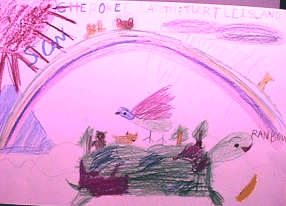 Lesson 1: While telling and drawing the story on the
blackboard, the kids draw the picture and write simple words on construction paper.
(This page is the second page of the picture book we are constructing over the course of
the year.
Lesson 1: While telling and drawing the story on the
blackboard, the kids draw the picture and write simple words on construction paper.
(This page is the second page of the picture book we are constructing over the course of
the year.
Student Survey Results
(a year-and-a-half after the class)
Lower Primary Grades
Nakamichi-Kita Primary School, third grade (actual class first grade), 29 students
1) What did you think of the lesson?
Learning things I didn't know was good (4 students). I want to see Joe's great-grandmothers face (2). It was interesting (2). I was very surprised (2). I thought it was great (1)! I was amazed that Joe's great grandmother was once alive (1). I'd like to go to Turtle Island (1). I want to ride the rainbow (1). I was amazed to see a rainbow over a turtle (1). I was good to know how the earth came to be (1). I want to listen to the story again (1).I thought that humans sure have come to live quickly (1). It was the most fun to hear a story like this when I was a first grader (1). I thought, wow, there is a turtle island (1). That there was a place on the shell of a turtle, made a strong impression on me when I was a first grader (1). When I tried to draw the picture I made a mistake when I drew the mountains (1). The part when the animals were sitting on the top of the rainbow was interesting (1).
2) What was the best part?
The animals sitting on top of the rainbow was fun (12 students). Drawing Turtle Island (4). The folk instruments from your country that you introduced (2). It was fun to hear all the parts of the story (2). Hearing your great-grandmother's story (1).
Nakamichi-Minami Primary School, fourth grade (actual class second grade), 29 students.
1) What did you think of the lesson?
It was interesting and good (7 students). It was good seeing and hearing the instruments from you country (4). I thought that your great-grandmother must have been a great person (3). That was the fist time I'd heard the story of turtle island (2). The sound of the dulcimer and the banjo sounded better than I had expected (2). I thought that it was too bad that the crawfish had his back burned (2). The animals were over the rainbow was mysterious to me (1). I could understand how people saw the shape of a turtle (1). I want to know more (1). It was difficult but fun (1). It would be great if there were lots of turtles on Turtle Island (1). I wondered how the animals over the rainbow felt (1).
2) What was the best part?
The folk instruments (12 students). The turtle (3). Drawing the picture (3). Understanding the shape of the turtle (1). The story (1). The pictures (1).
Nakamichi-Kita Primary School, fourth grade (actual class second grade), 27 students.
1) What did you think of the lesson?
Turtle Island was interesting (13 students). I could understand what a folk instrument is (3). It was interesting that there were animals on the rainbow (2). It was fun drawing pictures (2). I was amazed to hear that there were animals on the rainbow (2). It was very interesting to hear about the earth in this way (1). I want to go to Turtle Island (1). I could understand about the old times in North America (1).
2) What was the best part?
The folk instruments (8 students). Turtle Island was interesting and fun (3). Hearing a story that your great grandmother told you (2). It was fun drawing pictures of animals on the rainbow (2). The animals coming down from the rainbow (2). The turtle (1).
Toyotomi Primary School, fourth grade (actual class second grade), 35 students
1) What did you think of the lesson?
It was an interesting story (9 students). It was amazed to think of the earth as the shell of a turtle (5). Drawing the picture and hearing the story was fun (4). I thought that Joe's grandmother must be nice (3). I want to go to Turtle Island (2). I thought it was great that several animals were able to stay up for seven days (2). I didn't know there were Cherokee Indians in the world (1). I want to go to the top of a rainbow to see if there are any animals (1). It was a mysterious story (1). I thought it was wonderful that there were animals living on the turtle's shell (1). If the earth was really Turtle Island would be interesting (1). I was surprised that there was such a story in Joe's great-grandmother's country (1).
2) What was the best part?
Drawing the picture (14 students). The folk instruments (9). I thought that I'd like to see the earth as a turtle's shell (8). Animals on the top of the rainbow (2). Hearing about Joe's great-grandmother (1). Joe taught the class (1). Indian story (1).
Toyotomi Primary School, fifth grade--homeroom #2 (actual class third grade), 18 students
1) What did you think about the lesson?
Drawing the picture was fun (5 students). It was fun and interesting (2). I could learn about the animals and the crawfish getting sunburned was fun (1). The big Turtle Island was interesting (1). I want to make friends with the animals living on Turtle Island (1). It would be great if there really is such a turtle (1). I'd like to ride on this turtle (1). It was good that I could draw a picture of the turtle with the island on his back (1). It was good to hear all the stories of Turtle Island (1). The picture was very cute (1) ! It was a very fun story (1). I could understand the story of Turtle Island (1).
2) What was the best part?
Drawing pictures (3). Seeing and hearing you play the folk instruments(3). When we drew the turtle's picture (2). Hearing the story (1). Drawing the island on top of the turtle (1). I could understand a lot of English (1). The folk story (1).
Upper Primary Grades
Nakamichi-Kita Primary School, sixth grade (actual class fourth grade), 20 students
1) What did you think of the lesson?
Drawing the picture was fun (4). It was interesting to see the earth as a turtle shell and animals on top of the rainbow (3). It was fun to see animals living on the turtle's back (2). I could understand the old times (2). It is mysterious that there was a Turtle Island (2). The turtle shell is a real interesting metaphor for the earth (2). I thought, if the earth was once seen as a turtle, what do we think of it now (1). It was fun to see animals living on the turtle's back (1). Seeing that region's folk instruments was good (1).
2) What was the best part?
The folk instruments (4 students). Seeing animals on the turtle's shell, drawing the picture and writing words (4). Using the turtle's shell as a metaphor for earth (3). The part about the owl (1). The contents of the story (1). The Turtle Island concept was good (1). The part when the crawfish got his back burned (1).
Turtle Island
worldclass.net/storybox/kamejima/kame.html
English Explorers
(have fun learning world geography and
learning how English spread around the world)
The fourth story, English Explorers, is a fun introduction to world geography and a simple explanation of how the English language came to be used in so many parts of the world. The exploration begins with the largest landmass at the equator, Africa, and moves "on foot" to Europe and England. In England we learn about the invention of the steam engine and how the English people made a steam boat to go to India to buy tea. We draw our own boats and travel with the English Explorers to South Africa, India, Australia, New Zealand, and the Americas. The first part of the story ends in India and the second part continues on to Asia, Oceania, and the Americas. Students have fun drawing the world map and their steam-boat, and learn several English words (the continents and a few countries) and phrases (Where do you want to go?). The story requires two to three hours, including word recognition games. The story also prepares the students for exchanges with students in other countries.
Purpose and class outline
for two to five hours in the third semester
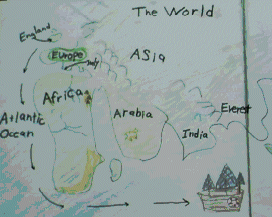 Lesson 1 (two class units) While telling and drawing the story of world
adventurers from a small island country, students draw the picture on construction paper.
Lesson 1 (two class units) While telling and drawing the story of world
adventurers from a small island country, students draw the picture on construction paper.
- Learn the question/answer phrase, "Where do you want to go?"
- Learn the English names of the continents and a few countries on each continent.
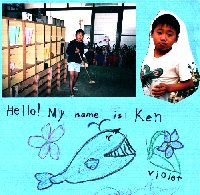 Lesson 2 (prepare
for an exchange of family and self-introduction cards with countries we choose.
Lesson 2 (prepare
for an exchange of family and self-introduction cards with countries we choose.
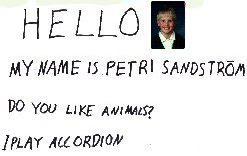 If there is more
time, and you want to use the project in other subjects:
If there is more
time, and you want to use the project in other subjects:
Student Survey Results
a week or two after the English Explorers (units 1
and 2) lesson
Lower Primary Grades
Nakamichi-Kita Primary School, third grade, 29 students
1) What did you think of the lesson?
It was interesting and fun (3 students). I could recognize many countries (3). It was fun to draw the map and explore so many places (2). The African folk instrument (KARIMBA) was good (2). It was good to go to Africa (1). While I was drawing the map, I started to really want to go to Argentina (1). This was the best lesson so far (1). I started to really want to go there (1). I could understand about islands (1). While drawing the map, I could identify many places (1). I could recognize many countries names (1). It was fun but I got little lost (1). It was difficult, but very interesting (1).
2) What was the best part?
Drawing the map and pictures (5 students). Drawing the shapes of many countries (3). The folk instruments (2). I could understand the English (2). Drawing the boat (2). Learning the English question, "Where do you want to go?"(2). Continuing the explorations of the world (1). I could understand a lot about different countries (1). It was interesting to go to so many places (1). I can remember a lot (1).
Upper Primary Grades
Nakamichi-Minami Primary School, fourth grade, 29 students
1) What did you think of the lesson?
I learned a lot (4). It was fun (4). I learned to use the English question, "Where do you want to go?" (4). It was difficult to draw a map for so many countries, but it was interesting (2). I was glad to have learned to use an English sentence (1). I could learn some English words and pronunciation (1). I learned how English spread around to different parts of the world (1). I wondered why we went to India to buy tea (1). I was glad to hear the folk instruments (1). I did not know that there was a country smaller than Japan (1). It was fun hearing about England (1). I understood a lot about different countries (1). I want to study like this a lot more (1). I thought that it was a feat to go to travel all the way to India to buy tea (1). I learned some English and sometimes something I already knew came out in the story (1).
2) What was the best part?
Drawing the map (6 students). Looking at the map, I choose some countries where I wanted to go (3). Drawing the map and writing English words myself (2). Drawing the map and remembering many countries (2). Taking a trip on a steamboat (2). Having a world adventure (2). Hearing lots of stories as we drew the map, it was like we went on a real adventure(1). Learning some English (1).
Nakamichi-Kita Primary School, fourth grade, 27 students
1) What did you think about the lesson?
It was fun and interesting (11 students). I understood many names of countries and places as we drew the maps (3). I thought is was amazing to go to India (2). I like adventures, so it was very interesting (1). It was fun to draw our own boats (1). It was good to take a trip to buy tea in India (1). It was interesting to draw so many countries (1). It was fun maps (1). I was surprised to know that there were such instruments (1). I want to go on the trip again (1). How English spread around the world was interesting (1). I understood that English can be interesting (1).
2) What was the best part?
Drawing the map (5). The folk instruments (1). The "great adventure" (1). Going to India by steam boat to buy tea (1). Traveling in boats that we drew (1).
Toyotomi Primary School, fourth grade, 35 students
1) What did you think of the lesson?
It was easy to understand, interesting and fun (9). It was amazing to go to India to buy tea (6). It was fun to draw so many countries; I could understand the world (5). It was good to draw the map and pictures of a giraffe and a lion in Africa (4). We got rich selling tea didn't we (2). I wanted to travel around the world (1). It was good that a lot of English came out in the story (1). I want to learn English fast (1).
2) What was the best part?
Drawing pictures of the boat, animals and the map (14). The folk instruments (5) How English spread around the world (2). I want to go anywhere in the world (2). Learning from where English came from (1). Learning about foreign countries (1). I could understand the English words (1). When I answered the question, "What else did the English go to India to buy?" correctly: "Black Pepper." The song was good (1). The story (1).The story was interesting (1). A world adventure is amazing (1). Remembering the English, "Where do you want to go?"(1).
Toyotomi Primary School, fifth grade, homeroom #2, 18 students
1) What did you think of the lesson?
It was fun (2 students). I'd like to go to all the countries and play many different instruments (2). I'd like to go to many different countries (2). I could understand many countries (2). It was the first time I had heard the story (1). It was the first time I'd heard many words, so it was good (1). It was difficult to understand so many new things (1). I can remember the folk instruments, but I soon forget the English (1). I got a good feeling from traveling all those places (1). I could understand where many countries are in the world (1). I thought it was amazing (1).
2) What was the best part?
Drawing pictures was fun (3 students). The interesting folk instruments (2). Drawing the world (1). Drawing different countries (2). Hearing different folk instruments (1). I was able to remember the phrase, "Where do you want to go?" Hearing so many different stories (1).
Nakamichi-Kita Primary School, sixth grade, homeroom #1, 20 students.
1) What did you think of the lesson?
It was good to start in Africa, visit so many countries, and hear stories (3). It was amazing to go on an adventure to buy tea (2). It was difficult to draw the map, but it was interesting (2). It was interesting to learn English names for countries and hear folk instruments (2). It was fun to draw boats on the construction paper and continue traveling (2). I was surprised that in the old days, Englishmen had to go all the way to India to buy tea (1). I want to go to many different countries (1). I want to go to Africa (1). I could understand the English question, "Where do you want to go?"(1). We don't have classes like this, so it was fun (1).
2) What was the best part?
Playing, touching, and seeing the instruments (5 students). The world adventure (3). Asking everyone "Where do you want to go?" (2). Drawing a map of the world and understanding what happened in the world (1). Drawing the world map was fun (1). It was easy to understand many things us on paper (1). Understanding the different countries that use English (1).
English
Explorers
worldclass.net/storybox/engexp/engexp.html
Exchange projects for primary and junior high school, and connections to other subjects and club activities
Primary school first grade exchange with a first grade class in Boston, U.S.A. (Introduction and commentary by the Japanese homeroom teacher
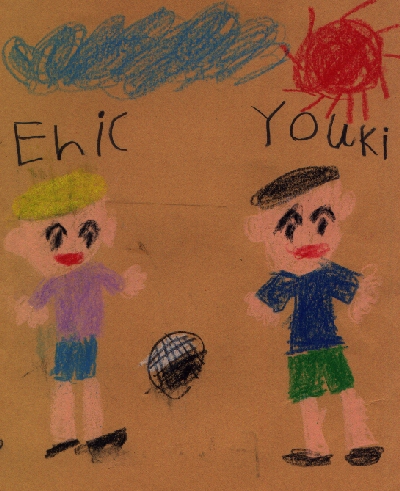 At the primary school
level I had several good experiences with exchange projects. Students have exchanged
self-introduction cards, artwork, and videos. Even a first grade class completed an
interesting project: Before we knew what the children over there looked like, we
tried to imagine what they looked like and then drew pictures of their faces. We
found that even at the first grade level, children had already formed impressions of
foreigners and foreign countries. The Japanese students imagined the students in Boston
with blonde or brown hair and blue eyes. (When drawing their own pictures, the hair
and eyes are always black.) When the Nakamichi students received the photos of the Boston
first graders, they were not as they had imagined them, and they soon found that many of
the faces looked like their classmates. After the exchange, the Nakamichi students
came to refer to the Boston students like neighborhood friends. Please read the
Nakamichi homeroom teacher's summary.
At the primary school
level I had several good experiences with exchange projects. Students have exchanged
self-introduction cards, artwork, and videos. Even a first grade class completed an
interesting project: Before we knew what the children over there looked like, we
tried to imagine what they looked like and then drew pictures of their faces. We
found that even at the first grade level, children had already formed impressions of
foreigners and foreign countries. The Japanese students imagined the students in Boston
with blonde or brown hair and blue eyes. (When drawing their own pictures, the hair
and eyes are always black.) When the Nakamichi students received the photos of the Boston
first graders, they were not as they had imagined them, and they soon found that many of
the faces looked like their classmates. After the exchange, the Nakamichi students
came to refer to the Boston students like neighborhood friends. Please read the
Nakamichi homeroom teacher's summary.
Upper Primary Grades
Exchange Project with France
Upper primary school grades and lower secondary grades have had successful exchanges with Finland, France, Italy, Australia, Canada, the U.S.A., and Korea. For example, first year students (seventh graders) in the junior high school recently made a web-page from self-introduction cards they received from an exchange with students in France the year before when they were in primary school. Some interesting features for our students include a French girl's hobby of horse-back riding, a school circus production, and a statue of Joan de Arc in the school's town. Please see the page the students made.
Junior High School English and Social Studies exchanges with the U.S.A. and Korea.
The U.S.A.: During the first semester of 1997, second year junior high school students (8th graders) exchanged e-mail with their peers in Hamilton, Ohio and Chino, California. Since English is the native language of most American students, we decided to write first in Japanese naturally to express more of our students personality, and then translate into English with help from the AET and the Japanese English teacher. We heard about the Ohio students plans for summer vacation and saw the school's web-page. While the Ohio students were of western European-American immigrant background, the Chino California students had just immigrated from Asian to America. The Chino students told us about their initial fears of learning English and making new friends in America. We realized that America is made up of many different ethnic groups with many different stories to tell.
Korea: From the
second semester of 1997 to the first semester of 1998, second and third year students
exchanged letters, gifts, and music with their Korean peers in InChon Junior High School.
Some interesting discoveries included the "Print Club" and the H.O.T. (High-five
Of Teenagers) dance bands which are very similar to those of Japan. And, especially,
the comments of a few Korean students regarding Tsushima, an island between Japan and
Korea which is in territorial dispute. "This island is ours!" wrote
several Korean students. Other students were glad that Korea would co-host the next
World Cup Soccer tournament in 2002. Generally, we found that Korean students very similar
to Japanese students except in regard to their consciousness of history. Our
students had virtually no opinion or interest in the island in dispute between the two
countries. We summarized our exchange in Korea web-page, and from the letters we
sent students to foreign students, we began constructing a "Japan impressions"
web page to describe our local region of Nakamichi-cho and Toyotomi-mura.
One more class project that helped our web-page design was a photo-album that first
and second years students made in their English class. In these photo-albums,
students applied question/answer patterns from their English textbooks to describe their
home, school, and regional ways of life. The AET was able to write comments and
questions in these books and to create further English dialogue with the students.
The students should want to keep their albums for years to come. See the "Naka-Toyo"
(Nakamichi-cho/Toyotomi-mura) web page that we have started from these materials.
Primary School Clubs and Volunteer Activities
Social Studies (International Understanding,
Environmental, and Multi-media education: The exchange projects we conducted in
the English class have obvious applications in the social studies class. The special
Japanese subject of international understanding, in particular, requires a wide variety of
applications in other subjects for successful learning.
If the social studies teacher learns how to use the internet and
e-mail, there are several good programs directed from within Japan. Adventurers and
archeologists help bring to children interesting places, history, nature, economics and
traditions. For example, the organization with the longest history of such
activities is World School Japan. In 1993, Takano brought her trip to the
North Pole to children via internet. The trip enabled a multi-curricular application
of environmental education for the three week expedition. Other adventures since
then have included annual trips in the late summer to various Micronesian islands in the
south pacific ocean. Adventures help link the island children with Japanese
children, so they can compare their natural environments, histories, and lifestyles.
During the second semester of 1997 sixth grade students at Nakamichi-Minami primary
school participated in World School Japan's Micronesia program. There was no
computer in the classroom, but the homeroom teacher handed out the reports to for students
each day and they gave daily oral presentations to the class. In other schools, students
broadcast their reports to the whole school for five minutes each day during the lunch
period. One time at Nakamichi-Minami, some sixth graders gathered in the teachers'
office, and in real-time, using a notebook computer, we communicated with Micronesian
students about what we saw in our natural environment, daily food intake, etc. As we got a
feeling for the natural, peaceful environment in Micronesia, and we also came to better
understand various environmental problems. A program like this could be used in
social studies or even science class.
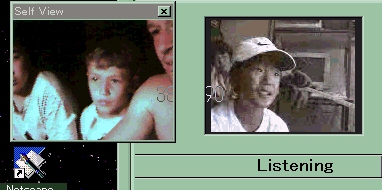
During the summer vacation of 1997, one junior high school student went to Georgia with
the AET and communicated in real time with three students at Nakamichi-Kita primary school
in the "Personal Computer" club. In the picture on the right a Japanese
boy is interviewing the AET's ten year old cousin about life in the Appalachian mountains.
From Georgia, we wrote and posted reports every day on our "Appalachian Adventure" web page
(worldclass.net/childviews/appalach97/findex.html).
The internet also aids studies of the local region. Introductions of businesses and schools both locally and across the state have grown to such a degree that the internet has become essential to the school library. Of course, if students have something they want to inquire about, they can ask anyone on the internet easily and directly. It would be a waste for the librarian not to know the basics of e-mail, internet searching, and making web-pages. With basic skills in making web-pages, the best school research, environmental-studies projects, can also be preserved in a way that teachers and students can continue building for years. Studies of the local environment, in particular, take years of successive follow-up studies to realize their value. The web-page format is ideal for such continued studies, and here are a few final examples of such possibilities.
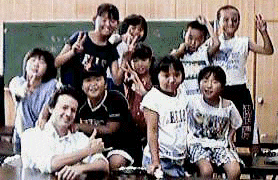 Clubs
and Volunteer Activities: Japan's Department of the Environment sponsored KODOMO
Eco-Club (Junior Eco-Club program) offers and ideal framework for continuing local
projects. Between 1996 and 1998, I was an official supporter of a club in
Nakamichi-cho. Many primary and secondary schools make designated Eco-Clubs in their
schools, but we decided that because the theme of ecology is so wide, we would use
existing clubs to incorporate Eco themes rather than create a new club. In the
primary schools we used the English Club and the Personal Computer Club; in the junior
high school, we used the Chemistry Club. We distributed the Department of the Environment
materials to the students and used the computer for these purposes. We also
incorporated the theme of international understanding. For example, in the materials
we received was an activity called "Earth Pizza" in which we studied the origins
of the ingredients in terms of their origin in the world and the amount of energy that was
consumed in making the product. Then we had fun making and eating the pizza.
Another activity involved making an "Eco-Map" of our local environment. We
also made regular observations of the natural environment around the school for a
year-long period. In such activities, the AET provides an important perspective
because he can describe similar conditions in his hometown, etc. The AET can also
help facilitate exchanges of the Eco-Maps with students in other countries.
Clubs
and Volunteer Activities: Japan's Department of the Environment sponsored KODOMO
Eco-Club (Junior Eco-Club program) offers and ideal framework for continuing local
projects. Between 1996 and 1998, I was an official supporter of a club in
Nakamichi-cho. Many primary and secondary schools make designated Eco-Clubs in their
schools, but we decided that because the theme of ecology is so wide, we would use
existing clubs to incorporate Eco themes rather than create a new club. In the
primary schools we used the English Club and the Personal Computer Club; in the junior
high school, we used the Chemistry Club. We distributed the Department of the Environment
materials to the students and used the computer for these purposes. We also
incorporated the theme of international understanding. For example, in the materials
we received was an activity called "Earth Pizza" in which we studied the origins
of the ingredients in terms of their origin in the world and the amount of energy that was
consumed in making the product. Then we had fun making and eating the pizza.
Another activity involved making an "Eco-Map" of our local environment. We
also made regular observations of the natural environment around the school for a
year-long period. In such activities, the AET provides an important perspective
because he can describe similar conditions in his hometown, etc. The AET can also
help facilitate exchanges of the Eco-Maps with students in other countries.
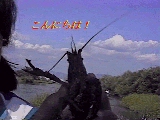
 Students who
participate in the nationally supported Eco-Club are also eligible to participate in the
internationally-sponsored G.L.O.B.E. (Global Learning and Observations to Benefit the
Environment). Students check regularly the regional weather, vegetation, soil, and
water conditions and send the information to N.A.A.S.A., who compiles the data sent from
over sixty countries and provides many interesting maps, graphs, and follow-up studies
incorporating the students data. Methods of participating in this program are
described in the materials distributed to the KODOMO Eco-Club members.
Students who
participate in the nationally supported Eco-Club are also eligible to participate in the
internationally-sponsored G.L.O.B.E. (Global Learning and Observations to Benefit the
Environment). Students check regularly the regional weather, vegetation, soil, and
water conditions and send the information to N.A.A.S.A., who compiles the data sent from
over sixty countries and provides many interesting maps, graphs, and follow-up studies
incorporating the students data. Methods of participating in this program are
described in the materials distributed to the KODOMO Eco-Club members.
If it were up to me, I would encourage children in student government bodies, the
chemistry club, the computer club, and the English club to continue their volunteer
participation in KODOMO Eco-Clubs. I would also call on the parents to participate
by helping to introduce to students their surrounding natural environment, history, etc.
Continuing such activities for many years is important. If this were to
occur, local "Eco-Maps" could be developed, related folk stories could be
included, and such materials could be exchanged with students in other countries. If
the exchanges were conducted successfully, students would begin to realize that the region
in which they live is connected to the whole earth. Please see the Eco-Volunteers page we shared between three
schools in our region (worldclass.net/childviews/Japan/nakatoyo/ecovol.html).